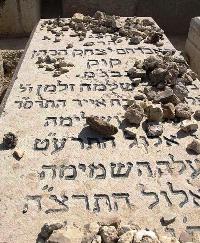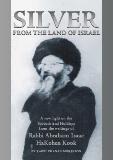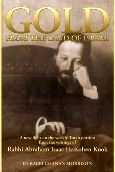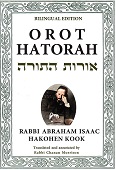For nineteen years, Rav Kook’s grave in the ancient cemetery in Jerusalem’s Mount of Olives was bereft of visitors. Jordan had obligated itself in the 1949 Armistice Agreement to allow ‘free access to the holy sites… and use of the cemeteries on the Mount of Olives.’ But Jordan failed to honor its commitments. During their nineteen-year occupation of Jerusalem, the Jordanians barred Jews from entering the site — the oldest and most distinguished Jewish cemetery in the world, in use since Biblical times.
Unable to visit Rav Kook’s grave, family members, friends and disciples worried about its upkeep and state of repair. Had they been aware of what was taking place in the Mount of Olives, they would have been more than just worried.
The Jordanian Caretaker

Three Hebrew dates are engraved on Rav Kook’s tombstone. The first is the 28th of Iyyar, 5664. That was the day in 1904 that Rav Kook ascended to the Land of Israel. The second date is the 28th of Iyyar, 5679 - when he ascended to the holy city of Jerusalem in 1919. And the third date is the 3rd of Elul, 5695, the day in 1935 when his soul ascended to heaven.
Following Rav Kook’s death, family members and disciples would visit his grave every year on the 3rd of Elul. But after the Jordanians captured East Jerusalem in 1948, this became impossible. The mourners made do with a memorial service in the Mercaz HaRav yeshivah. But ‘their hearts were in the East’ — in the abandoned cemetery on the Mount of Olives.
After Jerusalem was liberated in 1967 — on the 28th of Iyyar — families flocked to the cemetery to examine the state of the graves of their loved ones. The situation was far worse than they had feared. Most of the graves had been vandalized. Many were found opened, the bones scattered. The Jordanians had removed some 38,000 tombstones from the ancient cemetery, using them as paving stones for roads and construction material in Jordanian Army camps. Parts of the cemetery were converted into parking lots. A gas station was erected there, and an asphalt road was paved over it. The Jordanians built a luxurious hotel at the top of the Mount of Olives. Sadar Khalil, appointed by the Jordanian government as the cemetery’s official caretaker, built his home on the grounds using the stones robbed from the graves.
To the amazement of family and friends, however, Rav Kook’s grave was untouched. They rejoiced, “A great miracle has occurred here!” Some spoke of a miracle that the grave was left untouched, despite the artillery shelling during the ‘67 war.
A committee was established soon after the Six-Day War to investigate the cemetery’s desecration. The committee questioned the son of the Jordanian caretaker (the father had fled to Amman when the war broke out). Khalil Ibn Sadar Khalil explained that his father’s job was to make sure that only merchants who held special government concessions removed tombstones from the cemetery. “Workmen came during the day and pulled apart the stones and the tombstones. At night the army trucks came, loaded up the tombstones and drove off. The rest of the stones were taken by the merchants.”
When asked why Rav Kook’s grave had not been desecrated, Khalil explained, “We all knew that he was a great scholar, a holy man. It would have been perilous to damage his grave.”
The Neighboring Plot
“The righteous,” the Sages wrote, “are alive even after their death.” The following story reveals the influence of Rav Kook’s grave, some 50 years after Rav Kook’s passing.
Sanford (Zalman) Bernstein was a wealthy Manhattan investment broker who made a mid-life return to Jewish observance, much due to the influence of Rabbi Shlomo Riskin. Soon after he began studying with Rabbi Riskin, Zalman asked the rabbi to help him find a grave site in Israel.
Rabbi Riskin dutifully procured for him a burial plot in the historic Mount of Olives cemetery. The purchase, however, did not meet Zalman’s approval. The strong-willed broker, who flew in to examine his new piece of ‘real estate,’ was furious with the choice. “I can’t see the Temple Mount from this grave” he roared. “It is totally unacceptable!”
Zalman, never one to give up easily, searched the cemetery for a suitable plot. He was excited to locate an excellent spot — an available grave site with an unobstructed view of the Temple Mount. But the Jerusalem chevrah kadisha [burial society] was shocked at the suggestion. The plot was very close to the grave of the saintly Rav Kook. Given Zalman’s marital and religious status, this location was deemed completely inappropriate.
Rabbi Riskin tried to reason with Zalman — after 120 years, he wouldn’t be seeing anything from down below in any case – but Zalman would not relent. He quickly left the country, deeply disappointed.
The following week, Rabbi Riskin received a letter from Zalman, containing an apology as well as an explanation for his behavior.
“I'm not concerned about the view for myself. Before I met you and studied Torah, I made a mess of my life and had no message of inspiration to impart to my children. However, I ordered the grave in the hope that all was not lost. I felt that perhaps if, after 120 years, my children will visit my grave and gaze upon the holiest site in the world, where Abraham was ready to sacrifice Isaac and where generations of Jews offered prayers and gifts to God in the Holy Temple, they may become imbued with the ideal of sanctity which I could not give them in my lifetime....”
Rabbi Riskin translated the letter into Hebrew and brought it to the chevrah kadisha. He told them that he believed that by the time the grave site would be used, Zalman’s religious growth would be such that Rav Kook would be proud to have him as a neighbor.
The chevrah kadisha agreed to sell the plot to Zalman. The Manhattan broker began to study Rav Kook’s writings, and was deeply influenced by his teachings for the rest of his life.





